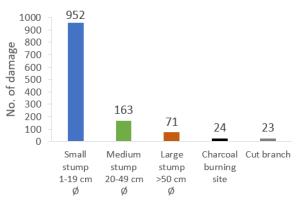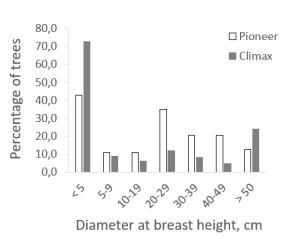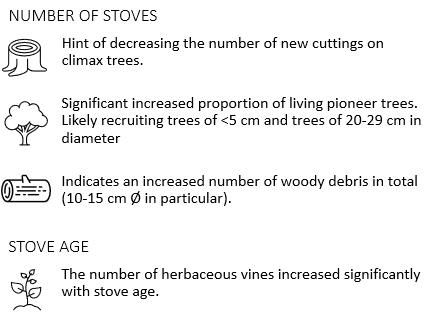Findings & Conclusion
The results presented on this page is only a selection and summary of all results from my study. To view all available data, please download the full report under Downloads in the menu to the left.
Firewood preferences

The results regarding occurrence of human made damage in the Kakamega forest indicate that there are some preferences when harvesting woody resources. People tend to cut stems and collect woody debris (logs) of <20 cm in diameter.
Presumably, also according to previous studies, stems with a diameter of < 10 cm are usually used as firewood and stems with a diameter of 10-20 is usually used for other purposes (e.g. building material).
Therefore, the damages found during my study are most likely not only caused because of harvest for firewood, but likely to constitute a considerable part of it. Climax type trees were found to be a preferred type of tree among locals harvesting woody resources. A previous study suggests that preference to be found among firewood collectors.
Consequences

The preference might cause the low abundance of the preferred size and type of trees that is shown in the general pattern of tree size. The number of logs of the preferred size also seems to decrease with higher pressure on the forest.
The figure on the right also show low abundance of trees of size 5-19 cm in diameter, both among trees of climax and pioneer type.
One can also observe a high abundance of recruiting trees (< 5 cm in diameter) among both succession types. Also a peak in pioneer trees of sizes between 20 and 29 cm in diameter.
Stove effect on forest structure
The effect that higher numbers of stoves have on forest structure could be summarized in four points:

The stoves seem to lower the amount of firewood collected in the forest. Fast-growing pioneers of the preferred size are therefore allowed to grow into a larger size class (20-29 cm in diameter). That might create a climate suitable for shade-tolerant, climax type trees to sprout and establish recruiting trees (<5 cm in diameter).
Utilization of energy-efficient cookstoves preserve woody debris found on the forest floor. This is an important structural component in a forest on many levels. However, the increased number of vines shown due to stove age is a sign that the forest is still experiencing human pressure creating gaps in the forest canopy.
Conclusion
The Kakamega forest is, with no doubt, still experiencing pressure from humans utilizing its resources. However, the installation and usage of energy efficient cookstoves seem to have some positive impact on the forest’s recovery and maturation. Though, future comparative studies, in the same fixed plot locations, are essential to be able to properly assess the cookstoves' efficiency regarding forest structure.
Responsible for this page:
Director of undergraduate studies Biology
Last updated:
05/13/20
